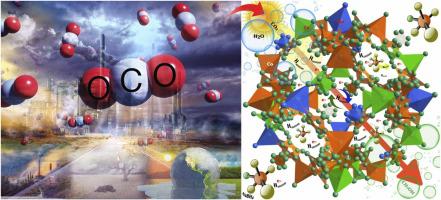Journal of CO2 Utilization ( IF 7.2 ) Pub Date : 2022-08-10 , DOI: 10.1016/j.jcou.2022.102172 Maryam Yousaf , Muhammad Ahmad , Zhi-Ping Zhao

|
Commercial application of CO2-to-fuel technology has been mainly restricted due to low-cut CO2 adsorption and activation by photocatalyst, thus contributing to low/impure fuel yield. Defect engineering of key CO2 activators onto excellent CO2 adsorbent along with in-situ & co-production of Hadatoms could address these issues. Herein, we report rapid conversion of CO2 to CH3OH in a photocatalytic system composed of CoxMoyZn1−x−yZIF-8 photocatalyst and NaBH4-assisted Hadatoms production. Doping of Co & Mo into ZIF-8 provided active centers for CO2 activation and structured highly efficient electron transport chains (ETCs) for selective conversion of continuous supply of CO2 into CH3OH (99%). Conversion of CO2 by CoxMoyZn1−x−yZIF-8 yields 9.96 mmole gcat-1 h-1 of CH3OH higher than reported ZIF-8 based photocatalyst in literature, and pristine ZIF-8, which only produced 94.2 µmole g-1 of carbon monoxide. Mechanistically, engineered doping of Co0.25/Mo0.25 in Zn-ZIF-8 enhanced visible light absorption and mechanized ETCs due to d-orbitals and multiple redox states, which largely expediated CO2 adsorption-activation. While in-situ & co-production of Hadatoms from NaBH4 and water spitting boost conversion of activated CO2 to CH3OH. Interestingly, the controlled release of Hadatoms from NaBH4 maintained a requisite charge gradient across ETCs, which was proven to be another reason for the high yield and selectivity of CH3OH.13CO2 analysis confirmed the source of C in CH3OH was supplied CO2, not by photocatalyst carbon that proved the stability of CoxMoyZn1−x−yZIF-8. We believe this work will be a step forward for commercializing revolutionary CO2-to-fuel technology, while results and novel interpretation will be key for multidisciplinary research.
中文翻译:

异金属多孔 ZIF-8 将 CO2 快速、高选择性地转化为甲醇
CO 2制燃料技术的商业应用主要受到光催化剂对低浓度CO 2的吸附和活化的限制,从而导致燃料收率低/不纯。将关键的 CO 2活化剂缺陷工程化到优秀的 CO 2吸附剂上,以及 H吸附原子的原位和联合生产可以解决这些问题。在此,我们报道了在由 Co x Mo y Zn 1-x-y ZIF-8 光催化剂和 NaBH 4辅助 H吸附原子组成的光催化系统中 CO 2快速转化为 CH 3 OH生产。将 Co 和 Mo 掺杂到 ZIF-8 中为 CO 2活化提供了活性中心,并构建了高效的电子传输链 (ETC),用于将连续供应的 CO 2选择性转化为 CH 3 OH (99%)。通过 Co x Mo y Zn 1-x-y ZIF-8转化 CO 2产生 9.96 mmol g cat -1 h -1的 CH 3 OH,高于文献中报道的基于 ZIF-8 的光催化剂和原始 ZIF-8,其仅产生 94.2 µmole g -1一氧化碳。机械地,Co 0.25 /Mo 0.25的工程掺杂在 Zn-ZIF-8 中,由于 d 轨道和多个氧化还原状态,增强了可见光吸收和机械化 ETC,这在很大程度上加速了 CO 2的吸附活化。而从 NaBH 4原位和联合生产 H吸附原子和水喷射促进活化的 CO 2到 CH 3 OH 的转化。有趣的是, NaBH 4中 H吸附原子的受控释放在 ETC 中保持了必要的电荷梯度,这被证明是 CH 3 OH高产率和选择性的另一个原因。13 CO 2分析证实了CH 3中C的来源OH 由 CO 2提供,而不是由证明 Co x Mo y Zn 1-x-y ZIF-8 稳定性的光催化剂碳提供。我们相信这项工作将是革命性的 CO 2燃料技术商业化的一步,而结果和新颖的解释将是多学科研究的关键。











































 京公网安备 11010802027423号
京公网安备 11010802027423号